BLACK FAMINE IN UKRAINE 1932-33
A STRUGGLE FOR EXISTENCE
by
Andrew Gregorovich
UKRAINE, "the breadbasket of Europe" is a land famous for
its fertile black earth and its golden wheat. Yet, only forty
years ago seven million Ukrainians starved to death although
no natural catastrophe had visited the land. Forty years ago
the people starved while the Soviet Union exported butter and
grain. While Moscow banqueted, Ukraine hungered.
Stark, cold, statistics, the accounts of thousands of Ukrainian
survivors and German; English and American eyewitnesses,
as well as confessions of Moscow's agents and the admission of
Stalin himself: All these have slowly seeped out of the Iron
Curtain and have been piled into a tremendous mountain of
facts. The whole story, pieced together like a jig-saw puzzle,
ends with the biggest puzzle of all: Why did Moscow decide to
starve to death seven million Ukrainians?
THE CLOAK OF DECEIT: "COLLECTIVIZATION"
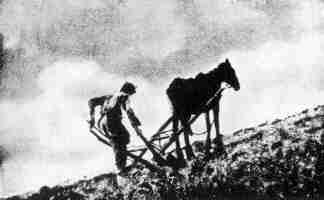 THIS GREAT CRIME OF GENOCIDE AGAINST the Ukrainian
people has not been completely ignored by the history
books of the world. Any history of the Soviet Union will
mention the triumph of "Collectivization" in which the Kulaks, or
well-off farmers, were "liquidated as a class." Collectivized
farming, which is today the most inefficient agricultural system
in existence, had to be instituted for Marxist reasons. The
Kulaks (Kurkulsin Ukrainian) constituted only 4 to 5% of the
peasantry -- yet they endangered the success of Communism!
THIS GREAT CRIME OF GENOCIDE AGAINST the Ukrainian
people has not been completely ignored by the history
books of the world. Any history of the Soviet Union will
mention the triumph of "Collectivization" in which the Kulaks, or
well-off farmers, were "liquidated as a class." Collectivized
farming, which is today the most inefficient agricultural system
in existence, had to be instituted for Marxist reasons. The
Kulaks (Kurkulsin Ukrainian) constituted only 4 to 5% of the
peasantry -- yet they endangered the success of Communism!
The Communist Party on January 5, 1930, as part of the
first Five Year Plan, started the machinery of Collectivization
rolling. Collective is, incidentally Kolkhoz in Russian and
Kolhosp in Ukrainian. The Russian peasantry demonstrated little
opposition to Moscow because of their past tradition of communal
farming. The Russian mir, or village commune, where the land
is owned by the village and not by the individual, had for centuries
prepared the Russians psychologically for Collectivization.
On July 30, 1930 the first RSFSR decree abolishing the mir was
passed to make way for the Collectives.
The Ukrainians, on the other hand, had an independent,
individualistic farming tradition of private ownershp of land.
The Russian communal spirit was comething completely foreign to
the farmers of Ukraine and so they opposed Moscow bitterly.
While the collectivization in the Russian Republic (RSFSR) went on
schedule, the stubborn resistance of the Ukrainians slowed it
down to such a standstill that Moscow even had to retreat
temporarily. This was noted by Stalin in his famous "Dizzy with
Success" letter. One way the Ukrainian farmer showed his
opposition to collectivization was by slaughtering his livestock
before joining. Later a death penalty was passed for such an
action. The folowing table shows the tremendous drop in
livestock:
| Livestock in Ukraine |
| |
Horses |
Cattle |
Sheep |
Hogs |
| 1928 |
5,300,000 |
8,600,000 |
8,100,000 |
7,000,000 |
| 1935 |
2,600,000 |
4,400,000 |
2,000,000 |
2,000,000 |
| Source: Ukrainian Encyclopedia, page 1064 |
WHY DID THE FAMINE TAKE PLACE?
OPPOSlTlON TO COLLECTIVIZATION is only half the story
why Moscow created the famine in Ukraine. The Ukrainian
opposition was not only ideological, that is against Communism,
but also political. Russian nationalism reared its ugly head at
this time. The Kremlin used the famine as a political weapon to
destroy Ukrainian aspirations for independence. At the same
time as the famine (1932-34) a wave of persecutions of thousands
of Ukrainian intellectuals, writers and leaders took place.
Plots for liberating Ukraine were discovered not only in the
smallest villages but even in the top ranks of the Ukrainian
Communist Party itself. Purges took hundreds of Ukrainians. Suicide
was the escape of many. In 1933 the famous writer Mykola
Khvylovy and the veteran Ukrainian Communist, Mykola
Skrypnyk, both chose suidde.
"This famine," says the American authority William H.
Chamberlin, "may fairly be called political because it was not
the result of any overwhelming natural catastrophe or of ...
a complete exhaustion of the country's resources... "
THE STRANGEST WAR IN HISTORY
THE DEATH AND DESOLATION caused by the famine is
likened to war by many of the eyewitnesses. And in fact,
the unequal struggle between the peasants of Ukraine and the
agent of the Russian Kremlin certainly may be accurately called
a "war". This Ukrainian-Russian "war" between peasants
armed with pitchforks and the Red Army and Secret Police, was
carried out mercilessly with no pity for the aged or young, nor
for women and children. According to Bertram D. Wolfe: "Villages
were surrounded and laid waste, set to the torch, attacked
by tanks and artillery and bombs from the air. A Secret Police
Colonel, almost sobbing, told the writer Isaac Deutscher:
"I am an old Bolshevik. I worked in the underground
against the Tsar and then I fought in the civil war. Did I
do all that in order that I should now surround villages
with machine-guns and order my men to fire indiscriminately
into crowds of peasants? Oh no, no!"
One Moscow agent, mighty Hatayevich, in reprimanding
Comrade Victor Kravchenko, one of 100,000 men "selected by
the Central Committee of the Party" to help in Collectivization
said:
"... I'm not sure that you understand what has been
happening. A ruthless struggle is going on between the
peasantry and our regime. It's a struggle to the death.
This year (1933) was a test of our strength and their
endurance. It took a famine to show them who is master here.
It has cost millions of lives, but the collective farm system is
here to stay, We've won the war."
Hatayevich, Secretary of the Regional Committee of the
Dnipropetrovsk Communist Party and one of the foremost
Communist in the Ukrainian SSR reveals here that the famine was
intentional, that it took millions of lives, and that he considered
it a "war" aganst the Ukrainian farmers.
One woman in Poltava said, "No war ever took from us
so many people." This was true, since Ukraine's losses in 1932-33
were greater than that of any nation that fought in the First
World War. It should be emphasized that the main weapon in
this struggle was not tanks, machine guns or bullets -- but
hunger. Famine, a man-made "Collectivized" famine, was the
main cause of the loss of life in this "war," one of the strangest
in history.
STALIN'S CONFESSION TO CHURCHILL
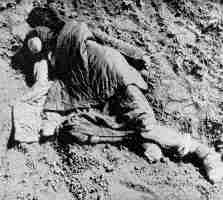 WHEN SIR WINSTON CHURCHILL visited Stalin at the Kremlin
in August, 1942 he asked: " ... Have the stresses of the
war been as bad to you personally as carrying through the
policy of the Collective Farms?"
WHEN SIR WINSTON CHURCHILL visited Stalin at the Kremlin
in August, 1942 he asked: " ... Have the stresses of the
war been as bad to you personally as carrying through the
policy of the Collective Farms?"
"Oh, no" he (Stalin) said, "the Collective Farm policy was
a terrible srtuggle ... Ten millions," he said, holding up his
hands. "It was fearful. Four years it lasted. It was absolutely
necessary ..."
Stalin admits that a complete year of World War II to him
was less of a struggle than Collectivization! How gigantic the
opposition of the Ukrainian peasants must have been. Stalin
went on to tell the British Prime Minister that some peasants
"agreed to come in with us" and were given land to cultivate
in Tomsk or lrkutsk (both in Siberia). "But," Stalin added,
"the great bulk (of the 10 million) were very unpopular and
were wiped out by their labourers (?)."
When Nikita Khrushchev "purged" Stalin in his 1956
secret speech, he didn't say a word about this Famine, the most
immense of Stalin's crimes. Instead, Khrushchev expressed
concern over the "thousands" of innocent Communists that had
suffered from Stalin's diabolical suspicion. It was on this
occasion that Khrushchev said that Stalin considered deporting the
population of Ukraine, however as Khrushchev says: "The
Ukrainians avoided meeting this fate only because there were too
many of them and there was no place to which to deport them.
Otherwise, he would have deported them also." In his book
Khrushchev Remembers (Boston, Little, Brown, 1970) the Soviet
premier devotes a chapter to the famine in Ukraine, 1945.
HOW MANY DIED?
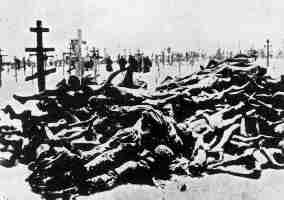 "CONSERVATIVE ESTIMATES place the number of deaths in
Ukraine due to this enforced famine, at about 4,800,000.
Many recognized scholars, however have estimated the number
between 5 million to 8 million."
"CONSERVATIVE ESTIMATES place the number of deaths in
Ukraine due to this enforced famine, at about 4,800,000.
Many recognized scholars, however have estimated the number
between 5 million to 8 million."
This statement from a United States Senate Document
(No. 122 of 1958) can be backed up with actual statistics
squeezed out of the Soviet press. The Russian government,
however, took special measures to keep secret the death toll.
Of course, it has never admitted any statistics or even the
existence of the famine. But, indirect references were accidentally
made and it is possible to estimate that during the famine from
10% to 25% of Ukraine's population (32,680,700 in January
1932) starved to death.
Vasyl Hryshko, in his factual study says that in 1935 about
25,000 people died daily in the villages of Ukraine, or more
than 1,000 per hour or 17 every minute. It was in early 1933
that the greatest loss of life took place. In the first half of
the year foreign travel in Ukraine was banned. No newspaper
correspondents were allowed to visit the besieged country until
the late summer and fall when signs of the famine had been
cleared up. The American journalist William Henry Chamberlin
visited Ukraine immediately after the ban on travel was lifted.
He says every village he visited had lost at least ten percent of
its residents.
Hryshko sums up the statistics of 1932 and 1939 in this way.
When we compare the 32,680,700 persons living in Ukraine in
1932 with the 1939 figure of 30,960,200 we see that, taking
into account the normal 2.36 per cent annual increase, in seven
years Ukraine had lost 7,465,000 persons. Of this number,
Hryshko says, some 4,821,600 persons or roughly 18.8 percent
of the Ukrainian population, died in the years 1932-1933.
The impact of the famine is shown in many ways. Just
before World War II a survey of the number of students was
made. Since children start school in the USSR at seven years of
age therefore, seven years after 1932 there should be an
indication of the famine by a drop in enrollment. Look at these
figures:
| |
Russian SFSR |
Ukraine |
Byelorussia |
| 1914-15 |
4,965,318 |
1,492,878 |
235,065 |
| 1928-29 |
5,997,980 |
1,585,814 |
369,684 |
| 1938-39 |
7,663,669 |
985,598 |
358,507 |
|
Source: Cultural Construction of the USSR, Moscow:
Government Planning Pub., 1940, pages 40-50.
|
The Russian Republic (where no famine took place), shows
a steady increase as did all seven other Soviet Republics, with
the exception of Armenia. Why did Ukraine have an absolute
loss of 600,216 students and Byelorussia (also a famine area)
11,174? The tragic story of these missing school children is
written in the pages of the man-made famine. Let us not forget
that Stalin himself said "ten millions" some of whom suffered
death not from famine but as slave laborers in Siberian mines
and timber camps.
EYE WITNESSES SPEAK
HUNDREDS OF UKRAINIAN eyewitnesses of the famine have
told their tragic and unbelievable experiences in the book
The Black Deeds of the Kremlin, edited by S. 0. Pidhainy. The
second volume of this work is devoted exclusively to "The Great
Famine in Ukraine." It should be added that some of the
people were able to travel to Moscow and other areas because
they were technicians, etc. They testify that while they left Famine
at the border of Ukraine or the Kuban (North Caucasus) area,
which is also Ukrainian populated, they found no evidence of
hunger in Russia or other Soviet republics, except Byelorussia.
It is not possible to give even a hint of the horror and pathos
in Ukraine at the time.
Writer Arthur Kaestler:
Arthur Koestler, the famous writer who visited Ukraine in
late summer of 1932 and fall 1933 and who spent about three
months in the Ukrainian city of Kharkiv writes in The God That
Failed:
"I saw the ravages of the famine of 1932-1933 in the Ukraine:
hordes of families in rags begging at the railway stations,
the women lifting up to the compartment window their starving
brats, which, with drumstick limbs, big cadaverous heads and
puffed bellies, looked like embryos out of alcohol bottles ..."
American Traveller Carveth Wells:
Carveth Wells, a world traveller, traveled through Ukraine
in July 1932 and describes the early stages of the famine in his
fascinating book Kapoot.
"The extraordinary thing was that the farther we penetrated
into the Ukraine, which used to be the 'Granary of Russia', the
less food there was and the more starvation to be seen on every
side."
"None of us knew what tragedies had been enacted here ...
"We ourselves happened to be passing through the Ukraine
and the Caucasus in the very midst of the famine in July, 1932.
From the train windows children could be seen eating grass.
The sight of small children with stomachs enormously distended is
not at all uncommon in Africa or other tropical countries, but
this was the first time I had ever seen white children in such a
state."
Soviet Official Victor Kravchenko:
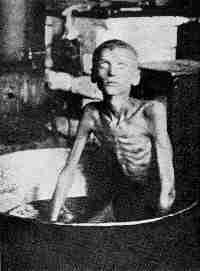 Victor Kravchenko was a Soviet official who escaped from
the USSR Embassy in the United States in 1944. He described
his life in the book I Chose Freedom. In 1933 he was one of
the Communist agents assigned to safeguard the new harvest,
the "Harvest in Hell" as he calls it:
Victor Kravchenko was a Soviet official who escaped from
the USSR Embassy in the United States in 1944. He described
his life in the book I Chose Freedom. In 1933 he was one of
the Communist agents assigned to safeguard the new harvest,
the "Harvest in Hell" as he calls it:
"Although not a word about the tragedy appeared in the
newspapers, the famine that raged ... was a matter of common
knowledge.
"What I saw that morning ... was inexpressibly horrible.
On a battlefield men die quickly, they fight back ... Here I
saw people dying in solitude by slow degrees, dying hideously,
without the excuse of sacrifice for a cause. They had been
trapped and left to starve, each in his own home, by a political
decision made in a far-off capital around conference and
banquet tables. There was not even the consolation of inevitability
to relieve the horror.
"The most terrifying sights were the little children with
skeleton limbs dangling from balloon-like abdomens. Starvation
had wiped every trace of youth from their faces, turning them
into tortured gargoyles; only in their eyes still lingered the
reminder of childhood. Everywhere we found men and women
lying prone (weak from hunger), their faces and bellies bloated,
their eyes utterly expressionless."
Kravchenko was shocked to discover a butter plant was
wrapping its products in paper titled in English USSR Butter
Export.
"Anger lashed my mind as I drove back to the village.
Butter being sent abroad in the midst of the famine! In London,
Berlin, Paris I could see ... people eating butter stamped with
a Soviet trade mark. Driving through the fields, I did not hear
the lovely Ukrainian songs so dear to my heart. These people
had forgotten how to sing. I could only hear the groans of the
dying, and the lip-smacking of fat foreigners enjoying our
butter ..."
At the same time Communist Party members and Soviet
officials, the privileged classes, were specially supplied with food.
Some of these, however, had a conscience and Comrade Somanov,
Chief of the Political Department said:
"Victor ... I'm of peasant origin myself and the sufferings
of my people hurt me deeply. Tears, blood, death, exile. And
why? The land is fertile, the people are hard-working. Why
must we let them starve and die and perish? The more I think
of it the more confused I get."
The famine was not caused by a lack of food in Ukraine.
This may seem a paradox but the cause of the famine was
completely the Kremlin's decision. It locked up Ukraine's food and
guarded it from the people. The Russian grain collectors did
not take only the wheat from the peasants but stripped them of
all food. In one village near Odessa "they collected all the
grain, potatoes, beets to the last kilogram" and "in other places
they even took half-baked loaves of bread from the stove."
These are not mentioned by Kravchenko. He does reveal however,
that these millions need not have died except at the whim
of Stalin in Moscow. He says:
"When the first of the new grain was being delivered to
the granary near the railroad station, I made a discovery which
left me tremulous with horror. Stacked in the brick structure
were thousands of poods of the previous year's (1932) grain
collections These were the state reserves for the district ordered
by the government, their very existence hidden from the starving
population by officialdom Hundreds of men, women and children
had died of undernourishment in these villages, though
grain was hoarded almost outside their doors!
"The peasants who were with me when we found the 'State
reserves' stared with unbelieving eyes and cursed in anger.
Subsequently I came to know that in many other parts of the
country the government hoarded huge reserves while peasants
in those very regions died of hunger. Why this was done only
Stalin's Politburo could tell -- and it didn't."
W.E.D. ALLEN
"Since that date (1926) catastrophes have befallen the
rural folk of the Ukraine about 3,000,000 are reckoned to have
perished during the famine of the early thirties, and another
2,000,000 certainly have migrated (to Siberia?) as a result of
conditions which they have found intolerable."
The Ukraine: A History, by W.E.D. Allen, Cambridge
University Press, 1941, page 375.
IVAR SPECTOR
"Hundreds of thousands of the recalcitrants were transported
to Siberia to work in the forest or mines. ... Others starved
during the famine which swept Ukraine in the early 1930's
particularly in 1932."
An Introduction to Russian History and Culture, by
Ivar Spector, D. Van Nostrand, New York, 1950.
GEORGE VERNADSKY
"... Largely as a result of the forcible collectivization of
agriculture, a famine developed in Ukraine. Starvation and all
it accompanying diseases stalked unchecked through the richest
agricultural region in the Soviet Union, and within the space of
a few months hundreds of thousands if not millions of people
died in unimaginable misery."
A History of Russia, by George Vernadsky,
Philadelphia, Blakiston, 1944, page 337.
"The famine of 1930-31 followed close on the heels of the
chaos, which existed everywhere in agriculture, and in Ukraine
in particular the suffering and starvation reached a scale which
almost passes human comprehension."
A History of Russia, by George Vernadsky,
New Haven, Yale University Press, 1954, page 360.
RICHARD CHARQUES
"But among the ghastly fruits of the campaign for
collectivization was the 'man-made famine' of 1931-32 in the Ukraine
and the northern Caucasus, where it had been resisted most
fiercely and where the fields had lain almost totally neglected.
There were millions of deaths from starvation in these regions."
A Short History of Russia, by Richard Charques,
London, 1959, page 245.
EDWARD CRANKSHAW
"At the same time Stalin had just forced through the collectivization
of agriculture ... at a fearful price ... First there
were the millions of ruined lives, the lives of the rich and middle
peasants, the so-called kulaks, killed in the struggle, or exiled
to Siberia; then the three million dead in the great famine
which swept Ukraine ..."
Russia by Daylight, by Edward Crankshaw,
London, Michael Joseph, 1951, page 100
|
"I'm still young and want so much to live a while"
|
|
-- Zina
|
|
This letter was written to K. Riabokin, a University Professor at
Kharkiv, by his niece Zina:
|
|
"Please, Uncle Do Take Me to Kharkiv."
"We have neither bread nor anything
else to eat. Dad is completely exhausted
from hunger and is lying on the bench,
unable to get on his feet. Mother is
blind from the hunger and cannot see in
the least. So I have to guide her when
she has to go outside. Please Uncle, do
take me to Kharkiv, because I, too, will
die from hunger. Please do take me,
please. I'm still young and I want so
much to live a while. Here I will surely
die, for every one else is dying ..."
|
|
----
|
|
The Uncle received the letter at the
same time that he was told of her death.
He says, "I did not know what to say or
what to do. My head just pounded with
my neice's pathetic plea: `I'm still young
and want so much to live ... Please do
take me, please ...'"
|
BERTRAM D. WOLFE
"The peasantry fought for its life with fowling pieces and
pitchforks. Uprisings embraced whole regions. Villages were
surrounded and laid waste ... Districts were stripped of their
stocks of grain and seed, then cordoned off to die of famine
and plague."
Khrushchev and Stalin's Ghost, by Bertram D. Wolfe,
Praeger, New York, 1957, page 165
"In 1932 the State decreed the death penalty for stealing
a bit of coal or grain from a freight train. Then the death
penalty was provided for the collectivized farmer who might
steal from the fields some of the product of his "collective labor;"
then for the willful slaughter of his own cattle; then for letting
"cattle die by neglect." "In March 1933, thirty-five officials
of the Commissariat of Agriculture were executed after being
'tried' ... for having 'willfully permitted noxious weeds to grow
in the fields.'"
Khrushchev and Stalin's Ghost, by Bertram D. Wolfe,
Praeger, New York, 1957, pages 169-71
DR. EWALD AMMENDE
"... Official Soviet reports referred to the 1932 harvest
as of medium quality: poor results or failure were never
mentioned. (page 29) 1933 was a particularly critical year for the
food supply of the Soviet Union. Nevertheless, 1.8 million tons
of grain and other foodstuffs were exported ... In the first
eight months of 1934, during which period the acute lack of
foodstuffs continued, the export was even more considerable;
591,835 tons of grain, worth 13.6 million roubles were exported
... via the Black Sea ports."
Human Life in Russia, by Dr. Ewald Ammende,
London, G. Allen & Unwin, 1936, page 46
WALTER DURANTY
"In the first fortnight of January (1933) ... Stalin made a
speech 'What is wrong,' Stalin asked in effect, 'on the agrarian
front? We are wrong, my comrades -- we, not the peasants nor
the weather, nor class enemies, but we Communists, who have
the greatest power and authority the world ever saw, yet have
made a series of blunders ... We miscalculated the new tactics
of hostile forces of boring from within, instead of engaging in
open warfare.'"
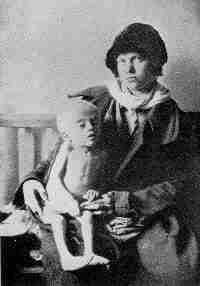
"In April, 1933, I travelled through Ukraine to Odessa,
and ... a Red Army brigade commander (General) told me:
'We had a communal farm in Ukraine attached to my regiment
... Everything went well until a year ago (1932). Then the
whole set-up changed. We began to get letters asking for food.
Can you imagine that, that they asked food from us? We sent
what we could, but I didn't know what had happened until I
went to the farm only a month ago (March 1933). My God,
you wouldn't beleive it. The people were almost starving. Their
animals were dead. I'll tell you more, there wasn't a cat or
dog in the whole village, and that is no good sign ... Instead
of two hundred and fifty families there were only seventy-three,
and all of them were half-starved. I asked them what happened.
They said 'Our seed grain was taken away last spring.' They
said to me, 'Comrade Commander, we are soldiers and most of
us are Communists. When the order came that our farm must
deliver five hundred tons of grain, we held a meeting. Five
hundred tons of grain! We needed four hundred tons to sow
our fields, and we only had six hundred tons. But we gave
the grain as ordered."
What was the result? I asked the brigade commander.
"Barren fields," he told me. "Do you know that they ate
their horses and oxen, such as was left of them? They were
starving, do you know that? Their tractors were rusty and
useless; and remember, these folks weren't kulaks, weren't class
enemies. They were our own people, our soldiers. I was
horrified ..."
USSR: The Story of Soviet Russia, by
Walter Duranty, New York, 1944, pages 194-5
MAURICE HINDUS
"The more well to-do peasants continued to resist the
movement, and to dispose of their opposition, the Soviets
proceeded to liquidate them."
The Great Offensive, by Maurice Hindus,
New York, 1933, page 154
"Worst of all the excessive collection of grain. This was
carried out with especial vigor."
(Hindus, page 151)
"Thousands (of people) came to Moscow, because they
knew that in Moscow there was an abundance of food. The
Ukraine with its lovely lands and its lovely skies and its lovely
white villages was siezed with panic and gloom. The mortality
of livestock from starvation during this time was enormous."
(Hindus, page 153)
"I never had seen such an abundance of weeds in the
fields as there were in the summer of 1932. Sugar beet in the
Kiev area (Ukraine) were literally submerged in weeds."
(Hindus, page 154)
Hindus quotes the Commissar of Agriculture, Yakovlev, who
spoke in February 1933 about the Peremozhetz collective farm
in Odessa region of Ukraine. "Here," said Yakovlev, "was as
choice a farm as there was in that part of the country -- rich
soil, superb climate -- Yet in 1932 it failed to fulfill the grain
obligation to the government even though the amount was
reduced to one-fourth of what it had been the year before, and
many a family had in hand only scanty supplies of bread. Of
its 153 horses, only 53 were left. The other 100 died of
starvation."
RONALD HINGLEY
"The same year (1932) also saw the outbreak of the second
great Soviet famine, in the Ukraine and along the Volga. It
claimed some five million further peasant victims -- deliberately
sacrificed by Stalin, who continued to dump Soviet grain on
world markets while those who had grown it were starving
en masse. The new dictator was very largely successful in
concealing this disaster from world opinion."
A Condse History of Russia, by Ronald Hingley,
New York, Viking Press, 1972, pages 172-73.
S.V. UTECHIN
"The next famine, that of 1932-3 was created artificially
by the authorities as a means of breaking the resistance of the
peasants to the collectivization of agriculture; ... the grain was
removed from the countryside by armed detachments chiefly
composed of internal security troops and Komsomol members.
(page 175) Millions of peasants died of starvation or were
deported and sent to forced labour camps." (page 120).
A Concise Encyclopedia of Russia, by
S.V. Utechin, New York, Dutton, 1964.
CLARENCE A. MANNING
"It is difficult to estimate accurately the number who
perished in the famine, but it was approximately 4,800,000.
This is certainly an underestimate, although certain other calcu-
lations will place the number between five and six million."
Ukraine Under the Soviets, by Clarence A. Manning,
New York, Bookman Associates, 1953, page 101.
JOHN F. STEWART
"While no official statistics about this tragedy have been
published, there is a document - The Small Soviet Encyclopedia
of 1940, in which it is stated that Ukraine had in 1927 a
population of 32 millions, and in 1939, only twelve years later, a
population of 28 million. Where had the 4 millions gone to,
apart from what should have been the natural increase of at
least another 4 million?"
Tortured but Unconquerable Ukraine, by John F.
Stewart. Edinburgh, Scottish League for
European Freedom, 1953. page 8.
 Return to FORUM: A Ukrainian Review Page
Return to FORUM: A Ukrainian Review Page
Copyright © 1974 Andrew Gregorovich
Reprinted from FORUM Ukrainian Review No. 24, 1974

since September 8th 1997
 THIS GREAT CRIME OF GENOCIDE AGAINST the Ukrainian
people has not been completely ignored by the history
books of the world. Any history of the Soviet Union will
mention the triumph of "Collectivization" in which the Kulaks, or
well-off farmers, were "liquidated as a class." Collectivized
farming, which is today the most inefficient agricultural system
in existence, had to be instituted for Marxist reasons. The
Kulaks (Kurkulsin Ukrainian) constituted only 4 to 5% of the
peasantry -- yet they endangered the success of Communism!
THIS GREAT CRIME OF GENOCIDE AGAINST the Ukrainian
people has not been completely ignored by the history
books of the world. Any history of the Soviet Union will
mention the triumph of "Collectivization" in which the Kulaks, or
well-off farmers, were "liquidated as a class." Collectivized
farming, which is today the most inefficient agricultural system
in existence, had to be instituted for Marxist reasons. The
Kulaks (Kurkulsin Ukrainian) constituted only 4 to 5% of the
peasantry -- yet they endangered the success of Communism!



